There has been considerable national attention in recent weeks on the declining quality of education in the United States, with criticism directed at the Department of Education’s efforts to address falling aptitude test scores, particularly in reading. According to a recent report from Education Week, reading scores for 4th and 8th graders have reached historic lows, despite an unprecedented influx of federal funding intended to support tutoring and other interventions aimed at mitigating learning loss. Education experts widely agree that achieving reading proficiency by 4th grade is a critical milestone for success in other academic disciplines, as well as for sustained educational progress in middle and high school.
National Scores Continue To Decline Post Pandemic
In 2024, students in grades 4 and 8 demonstrated lower reading performance on the National Assessment of Educational Progress compared to 2022. While math scores showed no change among 8th graders and saw a modest improvement among 4th graders, both groups continued to score below pre-pandemic levels.
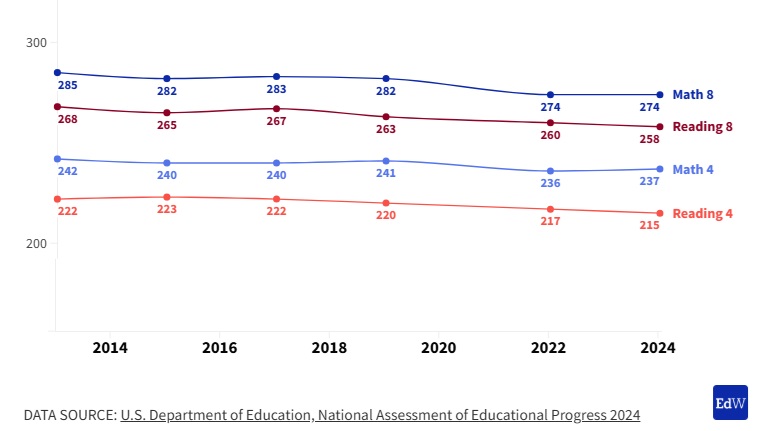
An in-depth look at reading scores highlights increasing concerns across the United States, as proficiency levels have stagnated or worsened, despite the allocation of billions in federal funding intended to address learning loss from school closures during the COVID-19 pandemic. The charts below illustrate the ongoing declines in reading performance among 4th and 8th-grade students.
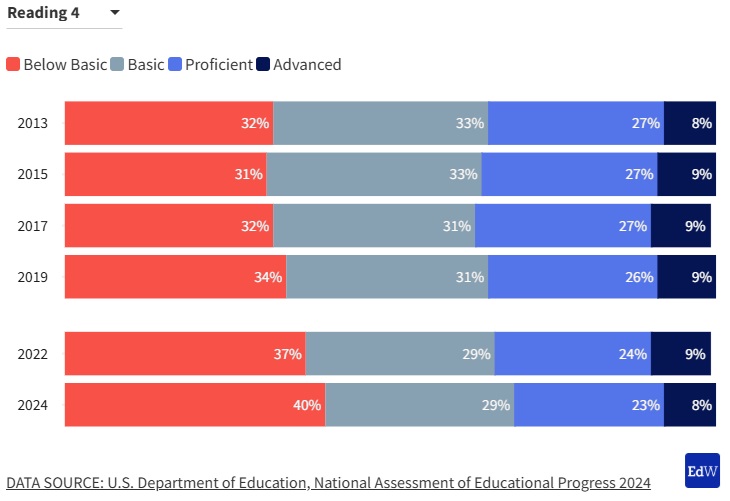
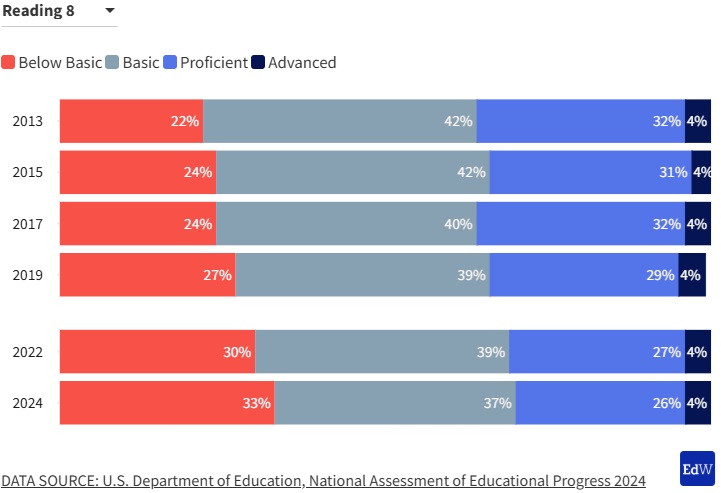
In 2024, 31% of 4th-grade students and 30% of 8th-grade students achieved reading proficiency. By comparison, in 2015, proficiency levels were at 36% for 4th graders and 35% for 8th graders. This represents a ~14% decline in reading proficiency at both grade levels over the past decade, with no clear signs of recovery.
How Does Pennsbury Reading Score Compare To National Trends?
During the January School Board Meeting, Pennsbury presented its Annual Achievement Report to both the Board and the public. The administration’s presentation appeared to emphasize a more favorable narrative, glossing over the challenges currently facing classrooms. The charts, carefully curated by the administration, relied on post-COVID pandemic data, seemingly in an effort to obscure the full extent of the struggles. However, as demonstrated by national assessments, comparing post-pandemic data to pre-pandemic test scores is essential to accurately gauge the scope of learning loss.
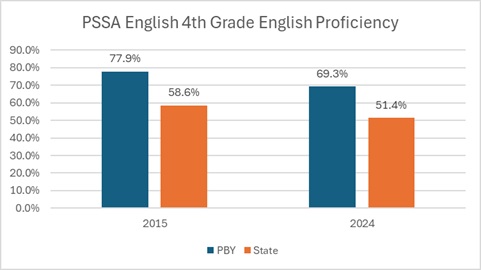
Pennsbury’s 4th-grade reading proficiency has declined by 11% over the past decade, decreasing from 77.9% in 2015 to 69.3% in 2024. While this decline is less severe than the national average of a 13.9% drop since 2015, and may suggest slightly better performance relative to nationwide trends, it still reflects a troubling double-digit decrease in achievement. Any suggestion of this being “good news” is questionable, as such significant declines are far from encouraging.
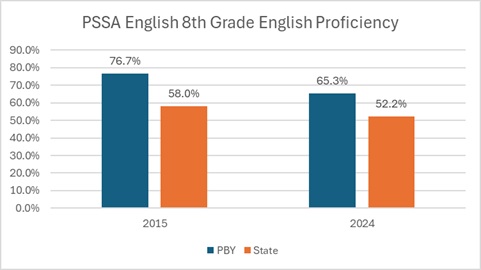
The 8th grade reading proficiency scores highlight serious concerns about Pennsbury’s efforts in the aftermath of the pandemic. For context, the 4th graders who took the test in 2024 were in kindergarten during the 2020 school closures, while the current 8th graders were in 4th grade at the time—making them particularly reliant on the federal funding allocated to school districts for tutoring and other interventions to help students regain grade-level proficiency. Pennsbury’s reading proficiency scores have declined by 14.8%, dropping from 76.7% in 2015 to 65.3% in 2024. Notably, this decline surpasses the national average, which fell by 14.2% over the same period, indicating a faster rate of decline in Pennsbury’s performance. Deeper concerns present themselves when compared to PA State averages which show a decline of 10% compared to 14.8% decline over the past decade.

Although there is no national assessment for high school reading proficiency, Pennsylvania’s Keystone testing provides a crucial glimpse into the challenges facing Pennsbury. The data highlights a troubling trend of declining proficiency as students near graduation. Between 2015 and 2024, Pennsbury’s reading proficiency plummeted from 90.8% to 74.4%, reflecting a dramatic 18% decline. By contrast, state-level scores experienced a 13.2% decrease during the same period, underscoring that Pennsbury is falling behind other Pennsylvania districts in recovering from the impacts of the pandemic.
What Is Pennsbury’s Strategy For Reading Proficiency Turnaround?
The reality is, there seems to be a lack of attention or concern from the Pennsbury administration and School Board regarding these declining metrics. Federal funds have been squandered on overpriced Promethean Interactive TV Displays, which are primarily beneficial for Elementary and Special Education students but have been installed in every Pennsbury classroom. Additionally, the School Board approved a six-figure expenditure on state-of-the-art classroom video cameras intended to support virtual learning, yet these cameras are absent from most classrooms.
The Policy Committee, under Jeannine Delwiche’s leadership, has squandered significant human resources and taxpayer money pursuing Title IX changes they knew were unlikely to become law. Now, the same committee is expending substantial time and funds resisting updates to its DEI and Transgender policies, effectively playing a high-stakes game with the Federal government over $3.4 million in funding intended to enhance reading proficiency. Meanwhile, they advocate for a $270 million new high school building, claiming it will boost learning outcomes—despite academic research indicating that 4th-grade reading proficiency is the most critical factor in academic achievement.
The Pennsbury administration and School Board might take a page from Louisiana’s playbook, a state that has achieved remarkable progress in education. Since 2019, Louisiana has been the only state in the nation to see improvements in both reading and math proficiency, climbing from 50th to 16th place in reading proficiency rankings. What’s the secret behind Louisiana’s success? Hint: It’s not costly equipment, progressive political agendas, or brand-new facilities. The key lies in returning to the fundamentals—focusing on Reading, Writing, and Arithmetic.